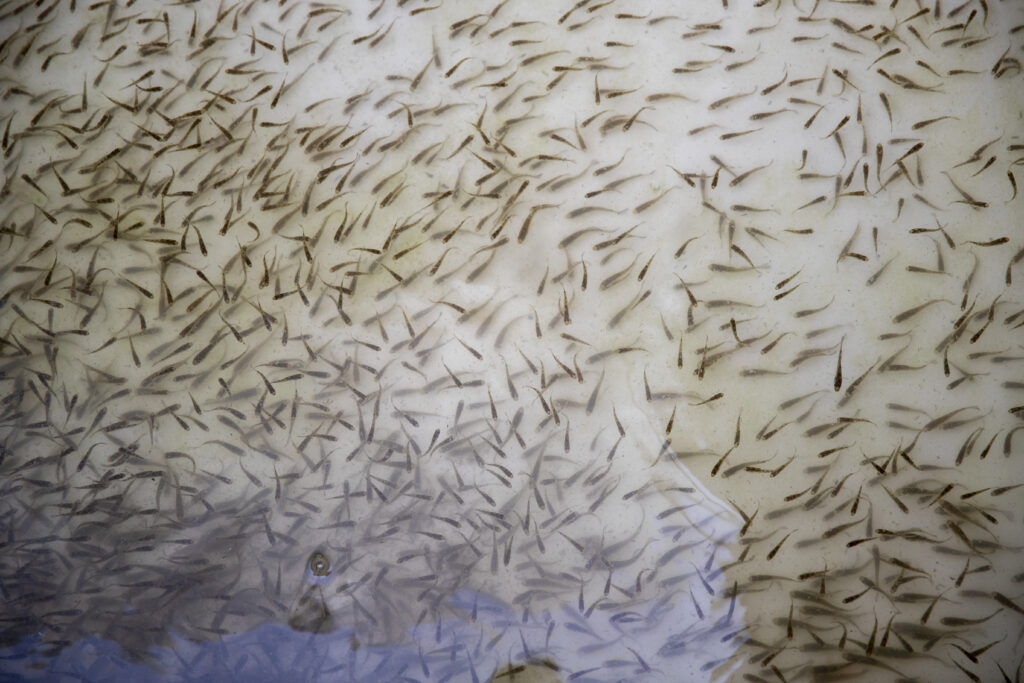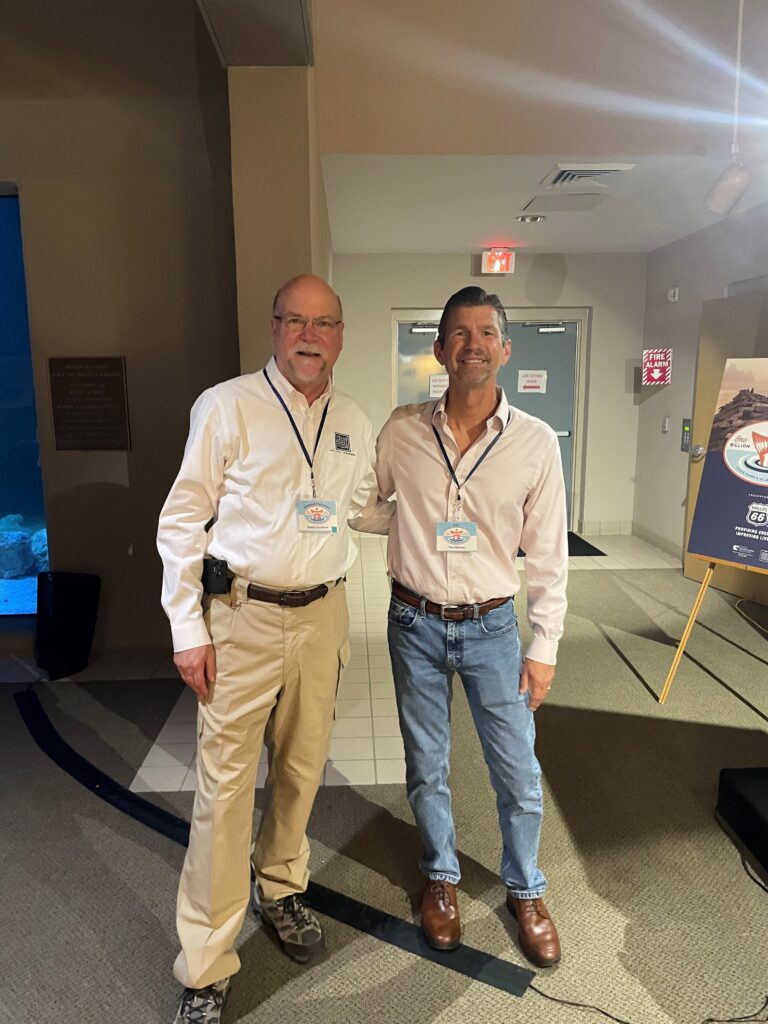
Dr. Robert Vega (Former Stock Enhancement Director for TPWD Coastal Fisheries) and his grandson, Noah, with “Billie” the one-billionth fish.

Fresh out of a harvested pond, red drum fingerlings await their stocking into your local Texas bay.
By Shane Bonnot, CCA Texas Advocacy Director
On July 31, 2024, a grand celebration was held as current and former Texas Parks and Wildlife Department (TPWD) staff, the Texas Parks and Wildlife Foundation, elected officials, Coastal Conservation Association (CCA) representatives, and distinguished guests recognized a monumental conservation achievement: the release of over 1 billion fingerlings into Texas bays and estuaries!
Since 1983, TPWD has been diligently releasing red drum, spotted seatrout, and, more recently, southern flounder fingerlings along the Texas coast. These efforts aim to bolster the natural recruitment of these economically valuable fisheries and support a thriving recreational fishery. While each stocking event varies in species, location, and number of fish released, the unwavering dedication of TPWD staff, across numerous careers, and the steadfast support from CCA have culminated in this remarkable feat of 1 billion fingerlings stocked over the 41-year timeframe.
The saltwater hatchery program began with a vision to revive the red drum population after decades of over-exploitation from commercial fishermen and rogue poachers. Initially named the John Wilson Marine Fish Hatchery, the CCA Marine Development Center in Flour Bluff was the world’s first red drum hatchery, a testimony to the power of partnerships and a shared vision by a state agency, a nonprofit conservation group, and a utility company. The Gulf Coast Conservation Association (GCCA) raised $1.4 million to construct the facility, Central Power and Light of Corpus Christi provided the construction site at its Barney M. Davis power plant, and the Texas Parks and Wildlife Department (TPWD) contributed staff and expertise. Critically, TPWD utilized broodstock conditioning and hatchery culture techniques developed by The University of Texas Marine Science Institute in Port Aransas and refined by TPWD’s marine research station in Palacios.
Today, the CCA Marine Development Center in Flour Bluff, Sea Center Texas in Lake Jackson, and the Perry R. Bass Marine Fisheries Research Station in Palacios collectively supply an average of 25 million fingerlings annually for stocking in Texas bay systems. This continuous success relies heavily on ongoing partnerships and collaborative efforts.

Dr. David Yoskowitz and Honorable Jeff Hildebrand “open the gate” to release 25,000 red drum fingerlings into Christmas Bay.

Dr. David Yoskowitz (TPWD Executive Director), Rep. Cody Vasut (District 25 State Representative) & Honorable Jeffrey Hildebrand (Texas Parks and Wildlife Commission Chairman) participating in the 1 Billionth Fingerling Release, holding “Billie” the one-billionth fish.
The GCCA, which evolved into today’s Coastal Conservation Association, began in Texas when a small group of recreational anglers grew concerned about overharvest in coastal fisheries. Since its inception and at the core, CCA’s mission has been to ensure the health, sustainability, and habitat of marine resources, while also protecting the interests of recreational anglers. Now a national advocacy group with chapters in 17 states, the CCA has numerous conservation achievements to its name. Fifty years ago, many believed the resources within the Gulf of Mexico and its bay systems were inexhaustible. However, declining populations, especially of red drum, became evident by the mid-1970s, prompting significant regulatory changes and conservation efforts.
Under the leadership of Walter Fondren III, the GCCA successfully lobbied for the Red Drum Conservation Act of 1977, which tightened commercial licensing requirements and set an annual harvest quota. In 1981, the GCCA secured the classification of red drum and spotted seatrout as game fish, ending commercial fishing for this species in state waters. This bold measure, followed by similar steps in other Gulf states and the permanent closure of the fishery in the federal exclusive economic zone in 1987, marked significant progress in fisheries conservation. Understanding early on regulations alone may not be enough for an expedited recovery, TPWD and GCCA began looking elsewhere for other fishery management tools.
During the mid-1970s, scientists at TPWD’s Perry R. Bass Marine Fisheries Research Station and the University of Texas Marine Science Institute pioneered the rearing of red drum in captivity to replenish wild populations. Researchers identified the temperature and lighting conditions needed for laboratory spawning and perfected the timing for moving larvae to rearing ponds. By the early 1980s, all the necessary elements for a successful production hatchery were in place and the stockings began in 1983 with 7 million red drum fingerlings released coastwide.
The need for additional facilities quickly became evident, and a new corporate partner quickly stepped in to join the cause –Dow Chemical Company(Dow). Dow’s involvementbegan in the 1980s after severewinters killed millions of fishin Texas bays. To diversifyhatchery locations, Dow builtred drum rearing ponds inFreeport at its Plant A location,stocked by TPWD with excesslarvae from the Flour Blufffacility. Between 1985 and 1995,these satellite ponds producedover 45 million fingerlings.
This success led to plans for a full-scale hatchery and education center in Lake Jackson. Dow donated 60 acres of land and CCA raised construction funds, supplemented by matching funds from the federal Sport Fish Restoration Program. Lake Jackson residents approved a bond to build infrastructure for the site. Today, Sea Center Texas occupies 75 acres and attracts over 60,000 visitors annually while serving as a hub for research and education.
CCA, Dow, Phillips 66, Shell Oil Company, academic institutions, and a host of other partners have all contributed as conservation partners to achieve the common goal of making fishing better. CCA remains a strong conservation partner for the hatchery program, which includes funding research, hatchery equipment, and conservation projects across all 3 facilities. Dow continually assists with SCT operations by supplying water through a pump station powered by their own electricity generation. Universities, marine scientists and students utilize the TPWD marine hatcheries and facilities for research projects and academic credit, advancing the science of conservation and stock enhancement efficacy.
While acknowledging the collective efforts of conservation partners is essential, the true credit for this monumental achievement belongs to the men and women who have devoted their careers to fisheries enhancement. Maintaining hatchery facilities in a corrosive saltwater environment, caring for broodstock year-round, timing spawning events, conducting hatchery culture, harvesting ponds and releasing fingerlings is not easy work. Long hours, arduous physical work, and harsh conditions are the norm. A billion things could go wrong throughout the process. Sometimes they do. Fortunately, thanks to the perseverance and dedication of TPWD staff and continued support from CCA and other partners, there are a billion reasons to be grateful. A billion opportunities for recreational anglers to enjoy the resource. A billion occasions for hope, and they are all out there swimming in our coastal waters.

Robin Riechers (TPWD Coastal Fisheries Division Director) and Pat Murray (CCA National President) visiting at the 1 Billionth Fingerling Release Celebration at Sea Center Texas in Lake Jackson.

Red Drum Fingerlings on display at the release location.

Red Drum fingerlings swimming inside the TPWD fish hauling trailer prior to being released into Christmas Bay.





